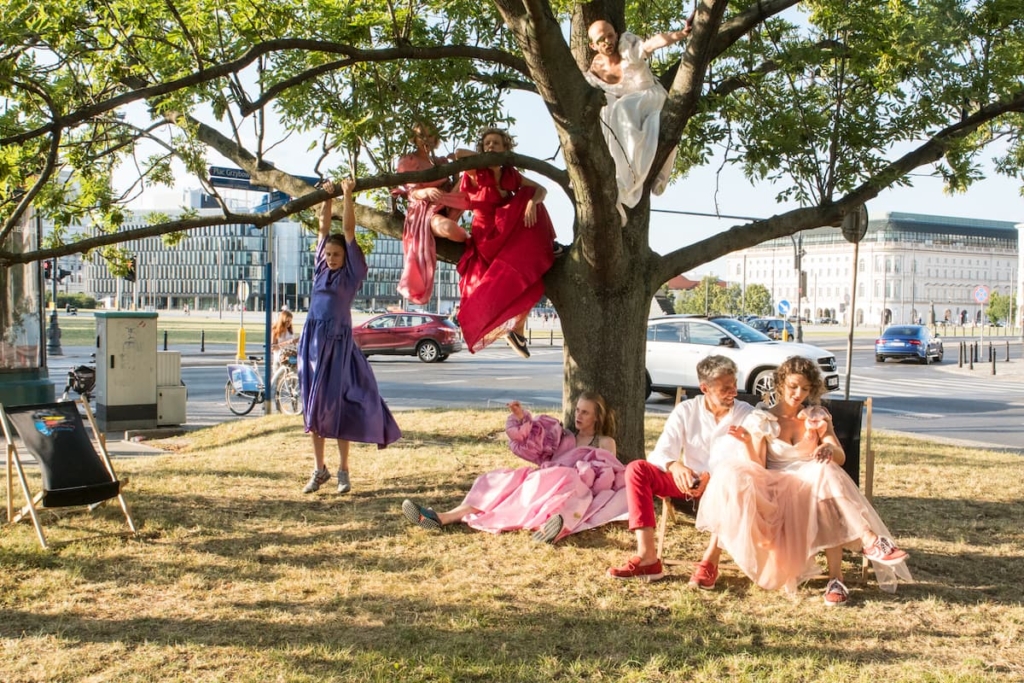Katarzyna Przezwańska
Plant potThe monumental pot, made by using an original mould preserved at the defunct workshop in Łysa Góra, decorated the entrance to the ZPR.
Since 2018, summer at the Zachęta has not been only associated with exhibitions, meetings or workshops, but also with Małachowski Square, which has become a natural extension of our gallery’s space. For two years, the square has remained a car-free zone, friendly to the gallery’s visitors and passers-by. This summer we will also mark our presence in this place, even though we have had to modify many of our plans. Invariably, you can count on watching Marek Sobczyk’s Simple Rainbow again there.
Magdalena Komornicka’s text opening the latest edition of the Zachęta Online Magazine will help you find out how we perceived the square still two years ago. The curator of the 3 Małachowski Square project looked at the Zachęta building and its surroundings through the prism of architecture and people – employees and visitors, mapping their needs and expectations and processing them in a creative way with the help of artists invited to participate in this unusual exhibition. Zusa Golińska’s spatial intervention into the gallery entrance, Katarzyna Przewańska’s fountain or Iza Tarasewicz’s installation Arena III, which surrounds the Zachęta building are just some of the activities carried out in the square in the four months of summer. We recall these events through photographic documentation.
Małachowski Square and the Zachęta building have often become the space for artistic activity. Looking back in time, we remember The 2nd Nationwide Interior Design Exhibition (1957), during which Wojciech Zamecznik erected a spatial “symbolic and propaganda decoration” in front of the building. And from our collection, we bring back Krzysztof Wodiczko’s video Projection on the façade of Zachęta (2005). The action preceded the artist’s monographic exhibition Pomnikoterapia (Monument Therapy). Wodiczko enlivened the building’s façade with women’s figures who took over the role of caryatids projected onto the two pilasters carrying the tympanum. The heroines of the projection talk to each other about their experience of physical and mental violence, of which they were not only victims but also perpetrators.
The Zachęta’s collection also includes Katarzyna Przewańska’s Flower Pot – a ceramic object designed for the exhibition Łysa Góra Experiment – 50 Years Later, which was an element of the gallery’s entrance at 3 Gałczyńskiego Street for a long time. In this way, we also revisit another outdoor space that we have been animating for several years – the summer terrace at the Zachęta Project Room. In 2018, on the initiative of the creators of the exhibition Amplifying Nature, presented in the Polish Pavilion at the International Architecture Exhibition – La Biennale di Venezia, another pot was erected on Małachowski Square – an aquatic plant tank from the 1960s. In cooperation with the Botanical Garden of Warsaw University, we restored its original function then, educating both the audience and ourselves about the fascinating world of aquatic vegetation. This summer the pot returns to the square, again filled with plants selected by the Garden’s employees! See the photos taken two years ago and the pot in 2020.
The eleventh issue of our online magazine, available from today at zacheta.art.pl, is its last weekly edition. Already on 24 July we are opening Monika Sosnowska’s individual exhibition and the magazine will present then premiere materials devoted to this show. Just a few months ago we would have published them in our Zachęta Magazine – a quarterly dedicated to current exhibitions and events at the gallery. In the pandemic reality, we keep combining the formats of both magazines, at least for a while. We are convinced, though, that it will help you find the most important and interesting contexts of our current exhibitions.
